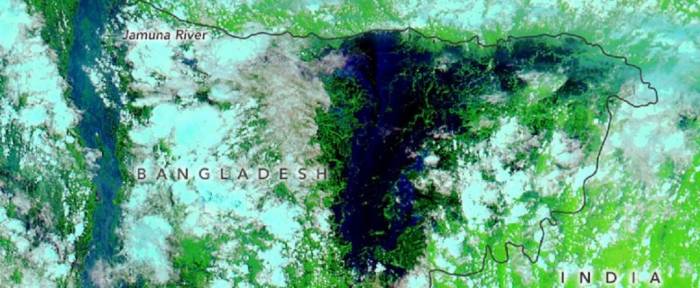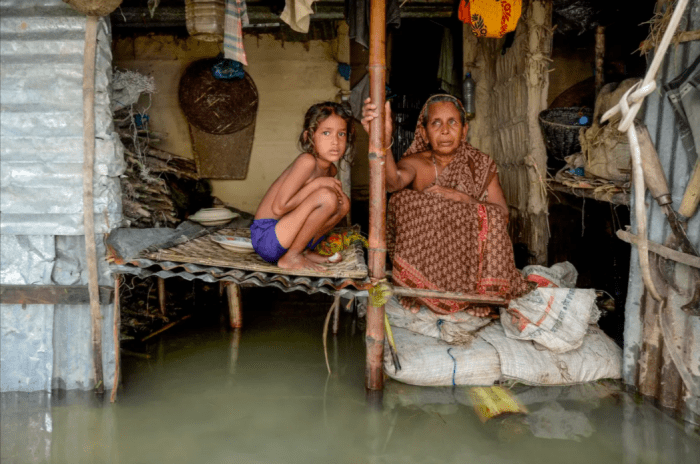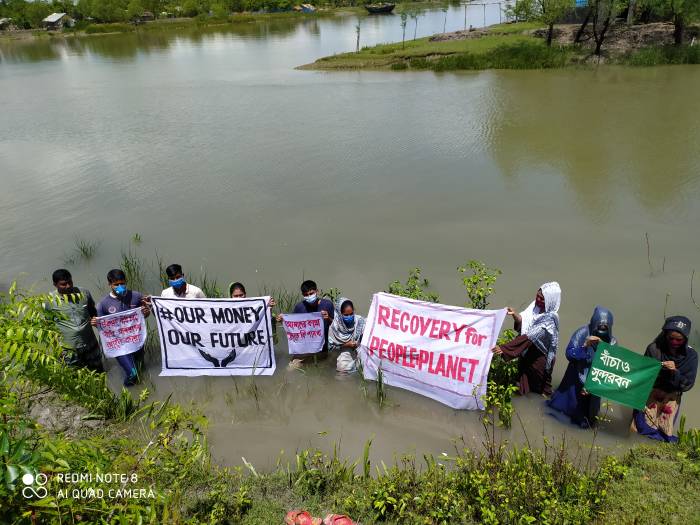Around one-third of Bangladesh is underwater as massive floods inundate the country. Bangladesh is yet to come out from the aftermath of Cyclone Amphan which hit the country in May and caused widespread devastation. Millions of people already impacted by COVID-19 and Cyclone Amphan will be pushed further into distress and poverty as a result of the floods.

A NASA image taken on July 25, 2020, showing the inundation of the country’s northeastern part in navy blue. Photo: NASA Earth Observatory
What we know
- Bangladesh’s Agriculture Ministry said the longest-running floods in recent memory had submerged nearly 80,000 hectares of paddy fields.
- This is the worst flood in a decade
- 53 rivers are overflowing
- 80,000 hectares of farmland underwater
- More than 3.3 million people had been impacted by the flooding and a third of the total are children, according to UNICEF.
Impact of Climate Change
The massive floods in Bangladesh are one of the glaring evidence of human-induced climate change.
So it is now apparent that the year 2020 is clearly the year in which the impact of climate change can be identified in both Cyclone Amphan that hit Bangladesh and India a few months ago, as well as the current flooding which is affecting millions of people as well as crops and property, Dr. Huq

A woman and a young girl sit in their flooded house in Sunamganj, north-eastern Bangladesh, earlier this month. Photograph: Munir Uz Zaman/AFP/Getty Images
From the frontlines of a flooded village in Bangladesh
Shahin Alam, a 19-year-old survivor of the recent cyclone’s wrath in Bangladesh, has been documenting the massive floods that ravaged his community. This is what he told DW in an interview after Cyclone Amphan,
“Cyclones don’t scare me anymore; what scares me is that we are dying slowly because of climate change. All our farmlands and shrimp enclosures have been submerged once again. It means we won’t be able to cultivate anything in the coming months. We have to rely on support from non-governmental organizations.”
Heavy rains and breaking of embankments have allowed salt water to enter the locality. Such is the situation in the southern coastal region of Bangladesh. Damaged by the adverse effects of climate change.@GretaThunberg @350 @YouthNet4CC @FFFinBD @SohanBMYP @SaleemulHuq @ pic.twitter.com/ZKS9nCihTU
— Shahin Billah (@shahin_billah) July 21, 2020
As a result of climate change and environmental disasters, Bangladesh goes under water every year.@GretaThunberg @FFFBangladesh @YouthNet4CC @SohanBMYP @350 @350SouthAsia @realDonaldTrump @shantaw_nur pic.twitter.com/6iJCWlIOiK
— Shahin Billah (@shahin_billah) July 20, 2020
A Just Recovery For Bangladesh
Bangladesh is one of the most vulnerable countries to climate change in the world. At the same time, the Bangladesh government has plans to build 29 coal plants in the country.
Bangladesh’s current plans to develop domestic coal production, importing LNG to meet domestic gas demands and expansion of coal-fired power (projected to reach a share of 35% by 2041) are not in line with the need to decarbonise the energy system and phase out coal for power generation by 2040, as a Paris Agreement-compatible pathway for South Asia.
Young people in Bangladesh and leading political figures are already calling for a Just Recovery. In the run-up to G 20 Finance ministers meeting in June, communities across the country mobilised to demand G20 finance ministers a just recovery package for the planet.

Youths from Satkhira, Bangladesh take action asking for a Just Recovery package from G20 finance ministers meeting in Saudi Arabia. Photo: Jannatul Mouwa
Saber H Chaudhury, parliament member from the ruling Awami League and standing committee member on petitions called for a Green New Deal for Bangladesh, a roadmap on the transition to 100% renewable energy by 2050 and “Build Back Future” post-COVID-19.
Gr8 to resume Committee work @jatiyoshangsad. Discussions about formulating studies, roadmap on transition to 100% #renewableenergy by 2050, promote #circulareconomy, reduce #pollution. #Bangladesh needs a #GreenDeal to #BuildBackBetter and recover from #COVID-19 at same time. pic.twitter.com/u4EHfTQIVL
— Saber H Chowdhury (@saberhc) July 26, 2020
What you can do now
Join us if you believe that this is a time to be decisive in saving lives and bold in charting a path to a genuinely healthier and more equitable future through a just recovery.